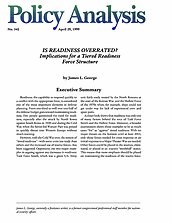However, with the Cold War over, the notion of “tiered readiness”–with some units less ready than others and the increased use of reserve forces–has been suggested. Opponents cite two major examples in arguing against any decreases in readiness: Task Force Smith, which was a green U.S. Army unit fairly easily routed by the North Koreans at the start of the Korean War, and the Hollow Force of the 1970s when, for example, ships could not get under way for lack of experienced crew and spare parts.
A closer look shows that readiness was only one of many factors behind the rout of Task Force Smith and the Hollow Force. Moreover, a broader examination shows those examples to be as much cases “for” as “against” tiered readiness. With no major threats on the horizon until at least 2015, only those forces needed for crisis response or an initial response to a Major Theater War are needed. Other forces could be placed in the reserves, eliminated, or placed in an inactive “mothball” status. This means that more emphasis should be placed on maintaining the readiness of the reserve force.

